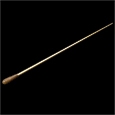Studying Mr. Moffat’s bald spot while he scribbled equations on the board, I shifted uncomfortably in my prefabricated combination desk/seat. A skinny, pale-faced man with a personality to match the most boring quadratic equation, Moffat coached track, but more importantly he taught my tenth-grade Algebra class. He was neither liked nor disliked; to have elicited opinions from the students, he would have been required to have a personality.
As Mr. Moffat droned on about parabolas and vertexes, I doodled randomly. No one in the class of tenth graders stirred until the classroom’s television purred to life like an omen from the heavens, mercifully ending another mathematical forced-feeding.
The television’s presence signaled the commencement of Channel One, one of the most inane but ingenious schemes ever wrought on the public schools. This 15-minute show mixed advertising, MTV-like clips, and pop culture polls wrapped up in an ADD-resistant presentation. The producers of this ubiquitous show furnished schools with hundreds of free televisions in exchange for the rights to brainwash hundreds of thousands of students with mindless commercials and copious merchandizing plugs.
I recall watching Channel One for the first time in middle school and being mesmerized. Midway through my second viewing, I had already tuned it out in favor of thumb wrestling.
One day as a trendy pseudojournalist vacantly read her canned lines from the teleprompter, students settled into its standard after-lecture routine. Nerds worked feverishly on their Algebra homework while those of us on the left side of the mental bell-curve initiated time-tested teenage gossip and flirting rituals.
Ignoring the blaring monitor, I looked around the room and noticed my best friend, Brandon, grinning stupidly at a cute sophomore girl in the row behind us. Sitting a couple of desks over from me, Brandon had completely turned around in his combo seat-desk to better engage the giggling cheerleader. Girls could not resist Brandon’s sandy brown hair, tanned body, and bulging muscles. There was no way that Brandon would squander his precious Channel One time on homework.
“Hey buddy,” Brandon called out to me as he smoothed his bangs back, still focusing on the cheerleader, “Why don’t you arm wrestle Walker over here and show him how that extra gym time has built your incredible biceps?”
Walker (no one knew his first name) was a hulking 16-year-old who enjoyed rugby, football, and any other activity that allowed him to maim other overgrown jocks without getting into too much trouble. During football season, he loved to wear his jersey to school, the store, and church. How he got into Mr. Moffat’s algebra class remains a mystery.
“Arm wrestle Sorenson?” Walker said licking his lips, “that would be like taking baby from a candy!” Before I knew it, Brandon had lined up Walker’s desk with mine.
Chattering students encircled the combatants and made several friendly bets in favor of Walker. With so many people around, I could not chicken out. Weighing 155 pounds and standing all of 5’6" tall, I was hardly imposing despite going to the weight room nearly every day. Looking across the conjoined desks into the eyes of Goliath, I thought to myself, “This is my chance to get the girls to notice me.” Reclining in his oversized chair behind his desk, Mr. Moffat peered intently at someone’s homework, oblivious to the drama in the classroom.
As Brandon clasped our hands together, the crowd moved in tighter – some stood on chairs to view the spectacle. Due to a longer forearm, I felt I had leverage on my side. As long as I kept my arm close to my body, it would be hard to pin. Brandon released his hands signaling the opening of hostilities. The gladiators’ muscles, tendons, and ligaments strained but amazingly, neither arm moved much. As the seconds passed, I was amazed that I hadn’t been pinned. Then I heard a crack as something in my upper-arm gave way. The full-force of Walker’s unrestrained force smashed the back of my hand on the cold, hard desk. The doctor later told me that the bone in my upper-right arm sheared in two. I gingerly cradled my throbbing right arm as Mr. Moffat escorted me to the main office through mostly empty hallways.
After an unpleasant trip to the hospital, I returned to school after lunch sporting an epoxy cast; it was obvious that I couldn’t play my violin in the orchestra for at least two months.
I sat in the back of that music class with nothing to do but watch the music director frantically waving his stick and shouting instructions over the sound of the orchestra. I realized that our music teacher, Mr. Bernstein (no relation), really did not know much about teaching orchestra. Because of budget limitations, the school employed two full-time music teachers to cover band, choir, and orchestra. This forced someone to teach the orchestra, although neither teacher was really qualified to do so. Bernstein was not incompetent; I just thought I could do a better job. Directing also seemed like a great deal of fun. As a tenth grader, I didn’t worry that teaching would pay less than some other professions.
In his own way, Mr. Bernstien inspired me to become an orchestra teacher. He showed me that teaching can be fun, even if he wasn’t great at leading the strings. Because of his limitations, I also recognized the importance of good training.
I have pursued music education with a string emphasis through three college degrees. I have conducted dozens of string orchestras and groups. There is no greater joy for me than helping orchestral students reach their potential under my baton.
My arm never did heal right. Even after months of excruciating physical therapy, my arm remained deformed, and it still will not extend completely. Maybe it’s not too late to sue Channel One.





